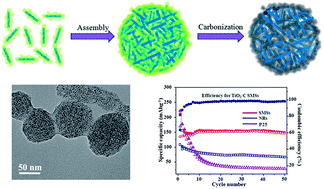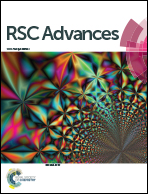Self-assembled hierarchical mesoporous TiO2–C sub-microspheres from nanorods and their improved properties for lithium storage†
Abstract
Hierarchical TiO2 sub-microspheres (SMSs) constructed from anatase TiO2 nanorods (NRs) are prepared by a simple bottom-up self-assembly approach. The assembly process is achieved by dissolving the oleic acid-coated NRs into cyclohexane solution and refluxing at 80 °C without any other surfactants or complex steps. The TiO2–C nanocomposite is synthesized by carbonization and the amorphous carbon layer is formed in situ on the surface of the nanorods, which could improve the conductivity of the electrode. The hierarchical structures of TiO2–C SMSs are verified by BET test results, which shows a typical type-IV isotherm curve and the pore volume of the SMSs is approximately three times that of the NRs, indicating the formation of three-dimensional mesoporous networks. As a Li-ion battery anode material, the assembled TiO2–C SMSs exhibit better electrochemical performance with enhanced capacity, greater cyclic stability and better rate performance compared to those of unassembled NRs or P25. Moreover, any other oleic acid-coated nanocrystals could be prepared by adopting this bottom-up strategy.


 Please wait while we load your content...
Please wait while we load your content...